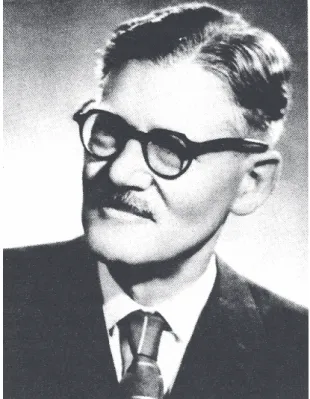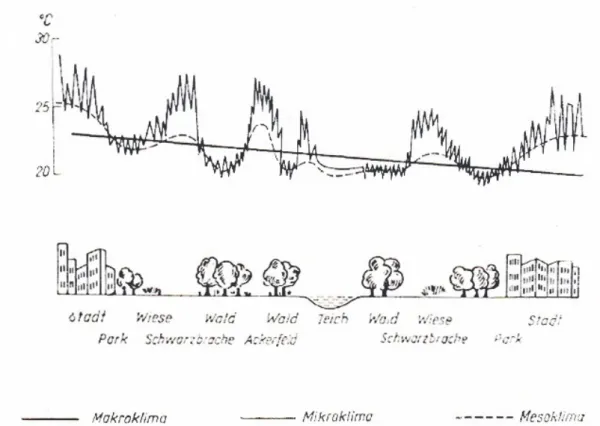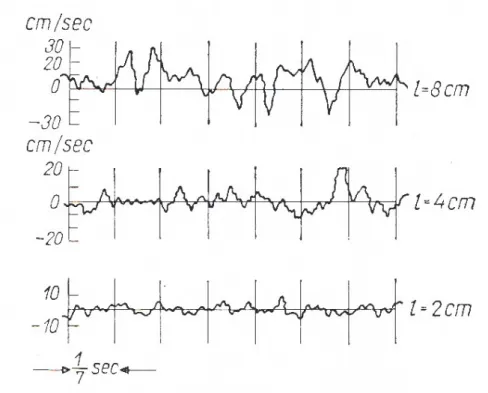DOI:10.28974/idojaras.2020.3.7
IDŐJÁRÁS
Quarterly Journal of the Hungarian Meteorological Service Vol. 124, No. 3, July – September, 2020, pp. 419–426
Short Contribution
From Geiger to the modern micrometeorology – the textbook of Dénes Berényi
1Thomas Foken
University of Bayreuth,
Bayreuth Center of Ecology and Environmental Research (BayCEER) Universitätsstraße 30, D-95447 Bayreuth, Germany
Corresponding author E-mail: thomas.foken@uni-bayreuth.de (Manuscript received in final form July 3, 2020)
Abstract⎯ The short historical outline describes the significance of Dénes Berényi's textbook “Mikroklimatologie” (Microclimatology, 1967, in German) for the present day.
Despite its limited distribution, it is an important document of the transition from the phenomenological to the physical based description of local climatological processes. In any case, it remains an important reference for climatology before 1960.
Key-words: Dénes Berényi, microclimatology, micrometeorology, history, textbook
1. Introduction
More than 50 years ago in 1967, Dénes Berényi published his textbook
"Microclimatology" in German. The manuscript was written around 1962 (Fig. 1). The textbook has been largely forgotten both because of the language and because of the political situations in Europe.
Before the Second World War, German language was a leading language not only in meteorology but also in Central Europe, and not only in Germany, Austria, and Switzerland. This may have prompted the author to choose this language, especially since Geiger's famous book "Das Klima der bodennahen Luftschicht” (The climate near the ground) was still read in German. Due to the
political division of Europe, however, Berényi's work became hardly known in the western part of Central Europe, while the eastern part was relatively insignificant in the international scientific landscape. Thus, the book was reserved only for a very small circle of readers, however, it would have deserved much more attention.
The author, Professor Dénes Berényi (1900–1971, Fig. 2) is the founder of the meteorological station at the University of Debrecen, where he also received his doctorate in 1927. He also lectured there on microclimatology. In 1951, he became the head of the Department of Meteorology and in 1952 he was appointed professor. He is the author of 6 books and about 80 publications. His memory is kept by the Hungarian Meteorological Society's Dénes Berényi Memorial Prize, awarded since 1993 (Szegedi, 2008; Varga, 2014).
Fig. 1. Title of Dénes Berényi’s book (Berényi, 1967).
Fig. 2. Professor Dénes Berényi (Szegedi 2008; Varga, 2014)
If one remembers the book today, it is its position in the transition from the classical microclimatic description in the sense of Rudolf Geiger (1894–1981) to modern textbooks of micrometeorology, which are strongly influenced by physics. The following article will show this transition by means of comparisons of contents. However, the book has a special significance in the history of science, as it covers many East European and Russian sources that would otherwise be completely forgotten.
2. From Geiger to Berényi
Rudolf Geiger, together with Wladimir Köppen, is not only the developer of the climate classification according to Köppen-Geiger, which is still used today, but he can also be described, without restriction, as the nestor of microclimatology. His book "Das Klima der bodennahen Luftschicht" (Geiger, 1927) has not only been published in many new editions (1941, 1950, 1961, reprint 2013), there is also an extension in English language available (Geiger et al., 1995, 2009). There is probably no one who works in this field and has not yet gained inspiration from this book. It would be too much to say that the book is structured according to ecosystems, but the structure does follow certain forms of vegetation (Table 1). On the way to Berényi, however, some other scientists have to be mentioned: Geiger's book was also based on Wilhelm Schmidt's (1925) fundamental work on the exchange coefficient. There is also a theoretical book on atmospheric turbulence by Heinz Lettau (1939) just before the Second World War. Not to forget the first comprehensive work on the energy balance of the earth by Fritz Albrecht (1940) and the first textbook on micrometeorology by Oliver Graham Sutton (1953).
However, Geiger's influence on Berényi's work is unmistakable, at least for the descriptive parts of the microclimate. Berényi, however, had a significant improvement in the physical-mathematical formulations, and the characterized the transition from classical microclimatology to micrometeorology.
Table 1. Comparison of the content of Geiger’s book „Das Klima der bodennahen Luftschicht” and Berényi’s book „Mikroklimatologie“
Geiger
*new in 4th edition
Berényi Earth’s surface energy balance –
the basic of microclimatology *
Introduction to microclimate
Air layer over flat surfaces without vegetation
Solar radiation
Influence of the underlying surface Heat exchange near the surface Daily and annual cycle of microclimatological elements Quantitative determination of the energy
balance *
Influence of the plant cover Forest climatology
Influence of the topography on the microclimate
Interrelationship between animals and humans to microclimate
3. Important contributions from Berényi
If one looks at the structure of Berényi's book (Table 1), it is immediately noticeable, in contrast to Geiger, that at the beginning of the book, the importance of radiation from the sun is shown, followed by the energy turnover on the earth's surface. The climatology is considered separately for the individual elements like radiation, temperature, wind, etc. In his fourth edition of the book, Geiger (1961) also gave more space to the heat balance on the earth's surface in the introductory section, but not with the clarity of Berényi's work. In principle, the structure introduced by Berényi has more or less established itself in the micrometeorological textbooks of the last 50 years, Monteith (1975, further editions with Unsworth 1990, 2008, and 2013), Stull (1988), Arya (1998, further editions 2001 and 2012), Foken (2008, further edition 2017). The development of micrometeorology in these years has recently been described in detail (Hicks and Baldocchi, 2020). While Geiger showed only the principles of energy turnover at the earth's surface, Berényi gives quantitative values (Fig. 3), referring to Baur and Philipps (1934, 1935) and Houghton (1954). Today, such presentations are included in all climatology and meteorology textbooks.
Fig. 3. Heat balance at the earth’s surface and in the atmosphere (Houghton, 1954; Berényi, 1967)
A further detail to be emphasized is the division of the scales into macro, meso, and micro – even before the introduction of Orlanski's (1975) scheme – based on a work by Saposhnikova (1950) with an interesting spatial averaging of the air temperature (Fig. 4). This introduces a principle of order, as is common today, even though Berényi does not yet link it to the temporal scales. However, the many and differently defined scale concepts in climatology are overcome (Hupfer, 1991).
Fig. 4. Classification of the scales of the climate (Saposhnikowa, 1950; Berényi, 1967)
Berényi has a strong hydrodynamic reference in his book, since he begins the theoretical sections with Prandtl's (1925) mixing length approach alongside the work of Schmidt (1925) and uses essential hydrodynamic works of the 1920s and 1930s, which formed the theoretical foundation of micrometeorology. Also important are the inclusion of turbulence and the description of the vortex structure near the ground. Here he refers to an illustration by Obukhov (1951), which is shown in Fig. 5. Thus, the book has crossed the border from the phenomenological description of the microclimate to a clearly theoretical underpinning corresponding to the approaches of the 1960s.
Fig. 5. Difference of the wind velocity between two points (Obukhov, 1951; Berényi, 1967)
Somewhat surprising is the extensive absence of the similarity theory of Monin and Obuhkov (1954), although it was already published in German in the 1950s (Monin and Obukhov, 1958). When listing the approaches to turbulent energy exchange, there is only a footnote that the method according to Monin and Obukhov can also be used, and that Kiss-Tóth (1959) has successfully applied it to the region of Lake Balaton. It is possible, however, that a paragraph in the book has been deleted, because the bibliography (consecutive numbering) contains some references to which there is no text in the book.
4. Significance of the book for the present day
The transition to a modern mathematical-physical based micrometeorology and thus also microclimatology was made with the Workshop on Micrometeorology (Haugen, 1973), so the earlier written book of Berényi was a pioneer in some areas, but it is only of historical interest today. In any case, the far-sightedness of the author must be emphasized, as he based Geiger's approach more on physics.
Thus, the work stands at the transition from the classical mixture length and exchange coefficient based approach to the similarity and turbulence theory. In the context of changing climate, local climatic changes are also of great interest.
Here, examples from the book can be quite helpful because of the strong physical base.
Apart from this scientific-historical aspect, it is above all a source for many forgotten Hungarian local climatological works before 1960, but also from the Russian and East European area, which are completely underrepresented in Geiger's book. In any case, the book remains an important document of the Hungarian meteorological and climatological sciences.
References
Albrecht, F., 1940: Untersuchungen über den Wärmehaushalt der Erdoberfläche in verschiedenen Klimagebieten, Reichsamt f. Wetterdienst. Wiss. Abh., Bd. VIII, Nr. 2, 1–82. (In German)
https://doi.org/10.1007/978-3-662-42530-5
Arya, S.P., 1998: Introduction to Micrometeorology. Academic Press, San Diego
Baur, F. and Philipps, H., 1934: Der Wärmehaushalt der Lufthülle der Nordhalbkugel im Januar und Juli. Gerl. Beitr. Geophys., 42, 160–207. (In German)
Baur, F. and Philipps, H., 1935: Der Wärmehaushalt der Lufthülle der Nordhalbkugel im Januar und Juli, Gerl. Beitr. Geophys., 45, 82–134. (In German)
Berényi, D., 1967: Mikroklimatologie, Mikroklima der bodennahen Atmosphäre. Akadémiai Kiadó, Budapest. (In German)
Foken, T., 2008: Micrometeorology. Springer, Berlin, Heidelberg.
https://doi.org/10.1007/978-3-540-74666-9
Geiger, R., 1927: Das Klima der bodennahen Luftschicht, 1. Aufl. ed., Friedr. Vieweg & Sohn, Braunschweig. (In German)
Geiger, R., 1961: Das Klima der bodennahen Luftschicht. Ein Lehrbuch der Mikroklimatologie. 4.
neubearbeitete und erweiterte Auflage, Verlag Friedrich Vieweg & Sohn, Braunschweig. (In German), reprint 2013 https://doi.org/10.1007/978-3-658-03519-8
Geiger, R., Aron, R.H., and Todhunter, P., 1995: The climate near the ground. 5 ed., Friedr. Vieweg &
Sohn Verlagsges. mbH, Braunschweig, Wiesbaden.https://doi.org/10.1007/978-3-322-86582-3 Geiger, R., Aron, R.H., and Todhunter, P., 2009: The Climate near the Ground. Rowman & Littlefield,
Lanham, XVIII.
Haugen, D.A., 1973: Workshop on Micrometeorology, Am. Meteorol. Soc., Boston.
Hicks, B.B., and Baldocchi, D.D., 2020: Measurement of Fluxes Over Land: Capabilities, Origins and Remaining Challenges. Bound.-Lay. Meteorol.https://doi.org/10.1007/s10546-020-00531-y Houghton, H.G., 1954: On the annual heat balance of the norther hemisphere J. Meteorol., 11, 1–9.
https://doi.org/10.1175/1520-0469(1954)011<0001:OTAHBO>2.0.CO;2 Hupfer, P., 1991: Das Klimasystem der Erde, Akademie-Verlag, Berlin. (In German)
Kiss-Tóth, E., 1959: Különböző talajok fölötti légrétegek hőforgalma a Balaton térségében. Időjárás 63, 1–6. (In Hungarian)
Lettau, H., 1939: Atmosphärische Turbulenz. Akad. Verlagsges., Leipzig. (In German)
Monin, A.S. and Obukhov, A.M., 1954: Osnovnye zakonomernosti turbulentnogo peremesivanija v prizemnom sloe atmosfery . Trudy geofiz. inst. AN SSSR 24 (151), 163–187. (In Russian)
Monin, A.S. and Obukhov, A.M., 1958: Fundamentale Gesetzmäßigkeiten der turbulenten Vermischung in der bodennahen Schicht der Atmosphäre. In (ed.: Goering, H.) Sammelband zur statistischen Theorie der Turbulenz. Akademie-Verlag, Berlin, 199–226. (In German) Monteith, J.L., 1975: Principles of Environmental Physics, Edward Arnold Publishers Ltd., London.
Obukhov, A.M., 1951: Charakteristiki mikrostruktury vetra v prizemnom sloje atmosfery. Izv. AN SSSR, ser. Geofiz., 3, 49–68. (In Russian)
Orlanski, I., 1975: A rational subdivision of scales for atmospheric processes. Bull. Amer. Meteorol.
Soc., 56, 527–530.
Prandtl, L., 1925: Bericht über Untersuchungen zur ausgebildeten Turbulenz. Z. angew. Math. Mech.
5, 136–139. (In German) https://doi.org/10.1002/zamm.19250050212 Saposhnikowa, S.A., 1950: Mikroklimat i mestnoj klimat, Leningrad. (In Russian)
Schmidt, W.: Der Massenaustausch in freier Luft und verwandte Erscheinungen. Henri Grand Verlag, Hamburg. (In German)
Stull, R.B., 1988: An Introduction to Boundary Layer Meteorology. Kluwer, Dordrecht.
https://doi.org/10.1007/978-94-009-3027-8
Sutton, O.G., 1953: Micrometeorology. McGraw Hill, New York.
Szegedi, S., 2008: History of the meteorological observations in Debrecen. AGD Landscape and Environment 2, 1–5.
Varga, M., 2014: Történelmi Arcképek: Berényi Dénes. Légkör 59, 139. (In Hungarian)



